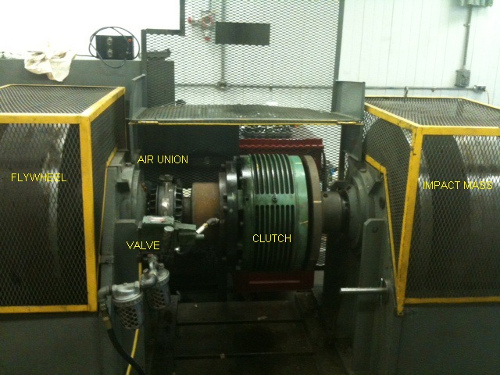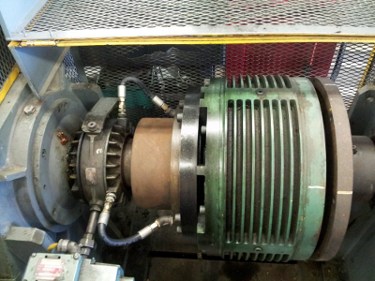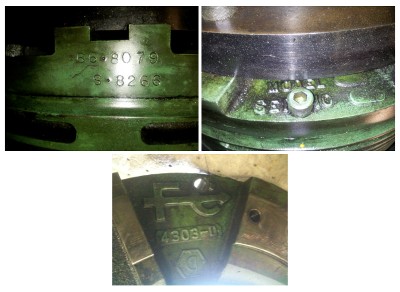 |
| June 18, 2013 | Volume 09 Issue 23 |
Designfax weekly eMagazine
Archives
Partners
Manufacturing Center
Product Spotlight
Modern Applications News
Metalworking Ideas For
Today's Job Shops
Tooling and Production
Strategies for large
metalworking plants
How long will your design last?
Oil-shear clutch earns rebuild after nearly 50 years on the job
For many employees in the automotive industry, 46 years is a career -- and then some. And most mechanical components would be worn out and replaced long before they reached that milestone. But for a Force Control Industries clutch on an axle fatigue test stand at a major automotive factory, 46 years is merely time for a rebuild. Now that the unit has been refurbished with some new parts, such as drive plates and friction discs, it is ready for its next five decades of service.

Axle test stand featuring nearly 50-year-old Force Control Industries clutch.
The Force Control model S8266 was, according to original schematics, designed into the test stand and delivered in June 1966. After running successfully until 2004, the original facility made the decision to get out of the axle test business and shipped the entire assembly to its new location. Operators at the receiving facility, not knowing the manufacturer of the unit and without benefit of installation, operation, and maintenance manuals, started the equipment and kept it running.
The test is driven by a 150-hp motor coupled to a flywheel. A second high-inertia flywheel is coupled to the axle differential input shaft. The clutch is used to connect the second high-inertia flywheel (assimilating vehicle inertia) to the motor/flywheel, bringing it up to speed. For testing, the clutch is disengaged and the output axles are stopped with brakes, absorbing the flywheel inertia load through the axle assembly. The clutch is then engaged to the motor to accelerate the flywheel back up to speed to recycle the test. This can occur two to three times per minute. In terms of load on the clutch as presented by inertia from the flywheels, the worst-case scenario is 50 lb ft sec2 spinning at 150 rpm, and 50 lb ft sec2 at rest.

Clutch mechanism.
Different test parameters can be run. The setup is designed for life-testing the axle assembly or just a single component, or it can be run for a set number of cycles. Either way, the unit is run pretty much around the clock.
"If we're doing cycle count testing, the spec might call for 2,000 cycles," said a test supervisor for the auto manufacturer, "so we'll run 2,000 cycles, then send the part for inspection. It might come back for another 500 or 1,000 cycles. The number changes depending on the part. Sometimes we'll get a failure on the second or third time around."
When that happens, they'll install another part and continue on.
"We might be running two or three different tests at the same time, depending upon when we have to put them on and take them off," he continued.
The test stand has been operating in its present location since 2005. Since then, it has seen close to 24/7 operations. While the test is running, the clutch will be activated two to three times per minute. During a 24-hr period with several part changes, the clutch might be running for 18 to 20 hr. Figuring on 18 hr of run time, with 2.5 cycles per minute, the clutch delivers 2,700 cycles per day or 972,000 cycles per year (based on a 360-day year).
With that production level, the oil-shear clutch delivered nearly 7 million cycles since the equipment was installed in its new location in 2005. Also noteworthy is that because the equipment came without the original owner's manuals or documentation of any kind, the new operators were unsure of proper maintenance procedures -- so they did not perform any.
It is hard to imagine a piece of equipment performing day in and day out, for seven years with no maintenance or downtime -- especially when it is starved for oil!
One reason for this longevity and maintenance-free (and adjustment-free) operation is the equipment's design.
How oil-shear technology works
Normal dry clutches employ a sacrificial surface -- a disc or pad -- to engage the load. Having no good way to remove the heat caused from engagement between the disk and plate, this material must absorb the heat. These extremely high temperatures will eventually degrade the friction material. As the friction surface wears away and begins to glaze, the spring force is also reduced, causing the ensuing torque fade. This causes positioning errors that require adjustment or replacement of the friction surface.
Oil-shear technology plays a major role in ensuring that the axle test stand can operate continuously. Since a fluid film flows between the friction surfaces, as the clutch is engaged the fluid is compressed. The automatic transmission fluid (ATF) particles in shear transmit torque to the other side. This torque transmission causes the stationary surface to turn, bringing it up to the same relative speed as the moving surface. Since most of the work is done by the fluid particles in shear, by the time the surfaces actually meet or "lock up" wear is virtually eliminated.
In addition to transmitting torque, the ATF also helps to dissipate heat, due to a patented fluid recirculation system. Along with torque transmission and heat removal, the fluid also serves to continually lubricate all components -- thus extending their service life. Oil-shear technology also provides a "cushioned" engagement that reduces shock to the drive system -- further extending service life. Unlike dry clutches, the totally enclosed oil-shear system is impervious to external elements such as wet, dusty, or dirty environments. Since the layer of oil eliminates wear, the Force Control clutch provides a long service life. With elimination of wear comes elimination of adjustment -- and increased "uptime" for the axle fatigue test stand.
But even the patented oil-shear design has its limits. Eventually the clutch began slipping and stopped engaging. So maintenance crews began to investigate.
"When we drained the oil in preparation for the rebuild, we got about a cup of oil," said the test supervisor. "It was supposed to hold 22 quarts. So it has operated for a very long time without even close to the amount of oil required. It may even have been drained before they shipped it. We don't know for sure."
Even running virtually dry, the oil-shear clutch delivered nearly 7 million cycles since its installation in 2005. If we conservatively assume that the unit was run at half of that production schedule since its original installation, then its running total is close to 28 million cycles.

Whether you are making front- or rear-wheel-drive axle assemblies, widgets, or flux capacitors, 28 million cycles with virtually no adjustment and minimal maintenance is pretty impressive. And it is certainly time for a well-deserved rebuild.
Company officials are happy to report that after rebuilding, the clutch assembly is back in action and back to delivering its two to three cycles per minute so that the axle fatigue testing can continue ... shift after shift, day after day.
Given its history so far, maybe a son or daughter (or more likely a grandson/granddaughter) of one of the current workers will be on hand when the clutch assembly is rebuilt in another four or five decades.
Source: Force Control Industries
Published June 2013
Rate this article
View our terms of use and privacy policy
